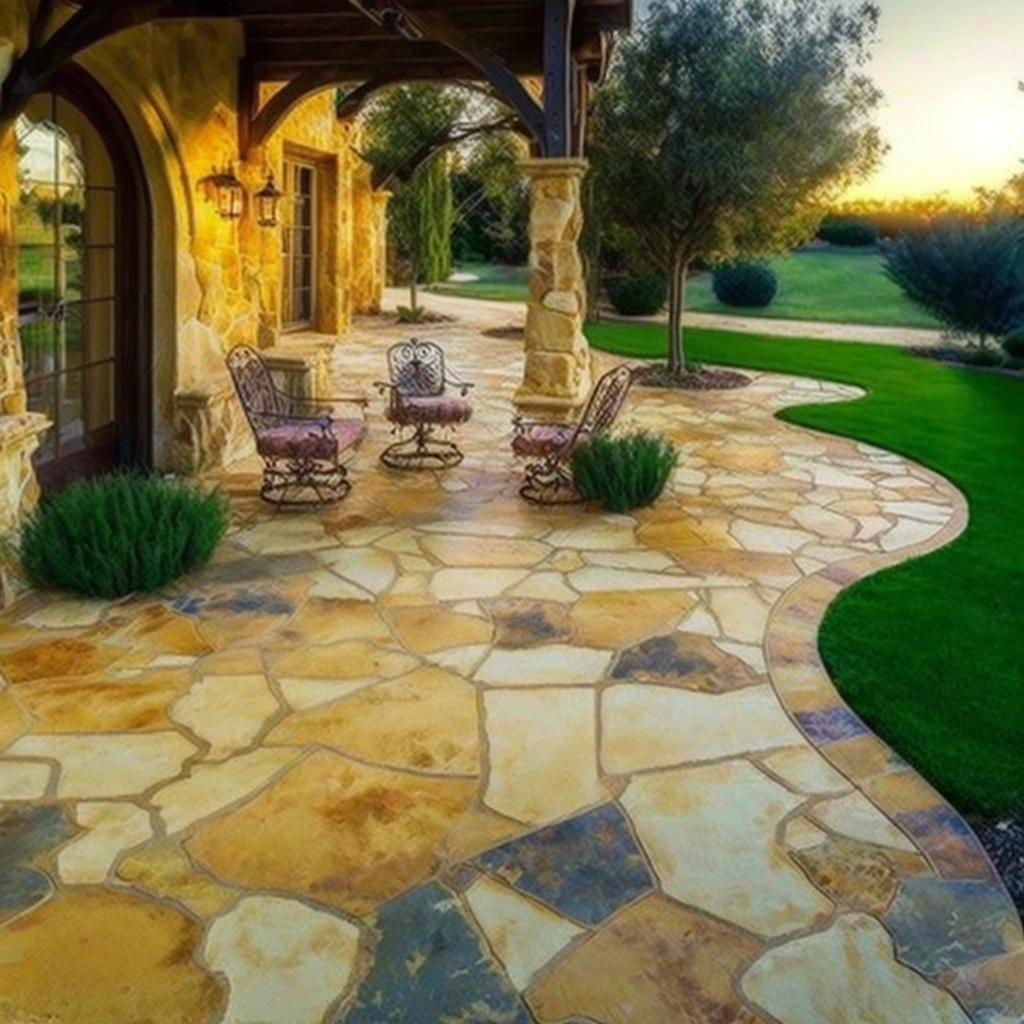Decorative Stamped Concrete
1. Introduction to Decorative Concrete
Decorative concrete is a versatile building material that offers a blend of durability and aesthetic appeal. It is a preferred choice for both residential and commercial properties looking to enhance their exterior and interior spaces. This comprehensive guide explores the four popular techniques of decorative concrete: stamped, stencil, acid stain, and epoxy, providing you with essential information to make an informed decision for your next project.
2. Stamped Concrete
Stamped concrete is a technique that replicates the look of stone, brick, wood, and other natural materials with remarkable accuracy. It is achieved by pressing molds into the concrete before it sets.
Pros and Cons
Pros:
- High aesthetic appeal with various patterns and colors.
- Cost-effective compared to natural materials.
- Long-lasting with proper maintenance.
Cons:
- Can be slippery when wet.
- Requires resealing every 2-3 years.
Application Process
- Preparation: The area is cleaned and prepared to ensure a solid base.
- Mixing: Concrete is mixed with color hardeners and release agents.
- Pouring: The concrete is poured and spread evenly.
- Stamping: Molds are pressed into the concrete to create the desired pattern.
- Drying: The concrete is left to cure, and sealant is applied for protection.
3. Stencil Concrete
Stencil concrete involves applying a stencil over the concrete surface and then applying color hardeners or stains to create patterns.
Pros and Cons
Pros:
- Wide range of patterns and designs.
- Less labor-intensive than stamped concrete.
- Durable and long-lasting.
Cons:
- Limited depth and texture compared to stamped concrete.
- Requires sealing to maintain color and prevent wear.
Application Process
- Base Preparation: The surface is cleaned and prepared.
- Stencil Placement: Stencils are placed over the concrete.
- Coloring: Color hardeners or stains are applied.
- Finishing: The stencil is removed, and the surface is sealed.
4. Acid Stain Concrete
Acid stain concrete uses a chemical reaction to achieve a variegated, translucent color effect on concrete.
Pros and Cons
Pros:
- Unique, one-of-a-kind color variations.
- Low maintenance and durable.
- Suitable for both indoor and outdoor use.
Cons:
- Limited color selection.
- Color results can be unpredictable.
- Acid stains are permanent and difficult to change.
Application Process
- Surface Preparation: Cleaning and preparing the concrete surface.
- Application: Acid stain is applied uniformly.
- Reaction: The stain reacts with the concrete, creating the color.
- Neutralization: The reaction is neutralized, and the area is cleaned.
- Sealing: A sealant is applied to enhance and protect the color.
5. Epoxy COATINGS
Epoxy Floor coatings are a type of resin applied over concrete floors, offering a smooth, durable, and high-gloss finish.
Pros and Cons
Pros:
- Highly resistant to stains, impacts, and chemicals.
- Wide range of colors and patterns, including metallic finishes.
- Easy to clean and maintain.
Cons:
- Application process is time-consuming.
- Can be slippery when wet without texturizing additives.
- Not suitable for outdoor use due to UV sensitivity.
Application Process
- Preparation: The concrete is prepared through grinding or shot blasting.
- Primer: A primer is applied to ensure good adhesion.
- Epoxy Coating: The epoxy resin is mixed and applied in layers.
- Decoration: Colors or chips can be added for decorative effects.
- Sealing: A topcoat is applied to protect the finish.
6. Choosing the Right Type
Selecting the right decorative concrete depends on several factors including budget, application area, desired appearance, and maintenance requirements. This section helps you compare the options based on these criteria.
7. Maintenance and Care
Maintaining stamped concrete is essential to preserve its beauty and extend its lifespan. Whether it’s a driveway, patio, floor, or wall, following a proper maintenance routine ensures your decorative concrete remains vibrant and durable over the years. Here are key tips on cleaning, resealing, and repairing decorative concrete surfaces.
Cleaning Decorative Concrete
Regular Cleaning: Sweep or blow away dirt and debris regularly. For indoor surfaces, dry mopping or vacuuming works well to keep the surface clean.
Washing: Use a garden hose with a spray nozzle or a pressure washer at a low setting for outdoor surfaces. For indoor surfaces, damp mopping with a mild detergent diluted in water is sufficient. Avoid using harsh chemicals that can damage the sealer or the concrete itself.
Stain Removal: Address spills and stains immediately to prevent them from setting. Use a non-abrasive cleaner for grease and oil stains. For tougher stains, consult with a professional for the appropriate cleaner that won’t harm the decorative finish.
Resealing Decorative Concrete
Timing: Reseal your stamped concrete every 2 to 3 years, or as recommended by the installer. High traffic areas may require more frequent resealing.
Choosing a Sealer: Use a sealer appropriate for your type of decorative concrete. UV-resistant sealers are recommended for outdoor use to prevent fading due to sunlight exposure.
Application: Ensure the concrete is clean and dry before applying the sealer. Apply the sealer evenly according to the manufacturer’s instructions, using a sprayer or roller designed for sealant application. Avoid applying sealer in direct sunlight or during extremely hot or cold temperatures.
Repairing Decorative Concrete
Cracks and Chips: Small cracks and chips can often be repaired using a concrete patching compound. For best results, choose a product that can be colored to match your decorative concrete.
Recoloring: Faded or discolored areas can be rejuvenated with a new coat of stain or dye, followed by sealing. Consult a professional to match the original color as closely as possible.
Professional Assessment: For significant damage, it’s best to have a professional assess the situation. They can provide solutions that ensure the repair blends seamlessly with the original surface.
Preventive Measures
- Use Protective Mats: For indoor floors, use doormats and area rugs in high traffic areas to minimize wear.
- Furniture Pads: Place protective pads under outdoor furniture legs to prevent scratches and scuffs on decorative concrete surfaces.
- Avoid Harsh Chemicals: Do not use deicing chemicals on outdoor decorative concrete, as they can cause surface damage and discoloration.
8. FAQS Concrete
What is decorative concrete?
Decorative concrete is a term that refers to concrete that has been treated, molded, colored, or textured in a way that transforms it from a plain, utilitarian surface into a design feature. Techniques include stamped, stencil, acid staining, and epoxy coatings, each offering unique aesthetics and functionalities.
How long does decorative concrete last?
When properly installed and maintained, decorative concrete can last for decades. The longevity depends on the technique used, the quality of materials, environmental conditions, and adherence to recommended maintenance practices.
Can decorative concrete be applied to existing concrete surfaces?
Yes, most decorative concrete techniques can be applied to existing concrete surfaces, provided the existing concrete is in good condition. Surface repairs and preparation may be necessary before the application of a new decorative treatment.
Is decorative concrete slippery?
Some decorative concrete finishes, especially those with high gloss or smooth textures, can be slippery when wet. However, additives and texturing techniques are available to improve traction without compromising aesthetics.
How much does decorative concrete cost?
The cost of decorative concrete varies widely depending on the technique, complexity of the design, size of the area, and regional price differences. Stencil and stamped concrete are generally more affordable than epoxy and acid stain techniques, but prices can overlap depending on specific choices.
Can I DIY decorative concrete projects?
While some simpler decorative concrete projects, like basic staining or stenciling, can be DIY-friendly, most techniques require professional equipment, materials, and expertise. Improper application can result in unsatisfactory appearance or performance issues.
How do I choose the right decorative concrete technique for my project?
Consider factors such as the desired look, the area’s function, maintenance requirements, and your budget. Research each technique’s characteristics and consult with a professional to match your project needs with the most suitable decorative concrete option.
How do I maintain my decorative concrete?
Maintenance varies by technique but generally involves regular cleaning and periodic resealing to protect the surface from wear and staining. Avoid harsh chemicals and use cleaning products recommended for your specific type of decorative concrete.
Can decorative concrete be repaired if it gets damaged?
Yes, most decorative concrete can be repaired, although the ease and invisibility of the repair depend on the extent of the damage and the specific decorative technique. Minor cracks and chips can often be fixed so that repairs are almost imperceptible, while more significant damage might require more extensive work.
Are there eco-friendly options for decorative concrete?
Yes, many decorative concrete options are eco-friendly, using sustainable materials and methods that reduce environmental impact. Look for techniques that utilize low-VOC (volatile organic compounds) products, recycled materials, and efficient installation processes to minimize ecological footprint.
9. Conclusion
Decorative concrete offers endless possibilities for enhancing the appearance and functionality of your spaces. By understanding the characteristics of each type, you can choose the best option for your needs and enjoy a beautiful, durable surface for years to come.
10. References
For further reading and exploration of decorative concrete techniques, visit reputable sources such as the Concrete Network, the American Concrete Institute, and local contractors specializing in decorative concrete.




ExcellentBased on 45 reviews
 Vern Milholen2024-03-19A & P was the first company we called and were excellent to work with. Professional in planning and execution. Clearly capable of small and large jobs; these are the guys to call if you need concrete work done right!
Vern Milholen2024-03-19A & P was the first company we called and were excellent to work with. Professional in planning and execution. Clearly capable of small and large jobs; these are the guys to call if you need concrete work done right! Terry Lamb2024-03-16Was prompt showed up when he said they would.done in a timely manner.and came back out and fixed some imperfections we found.all in all very work.
Terry Lamb2024-03-16Was prompt showed up when he said they would.done in a timely manner.and came back out and fixed some imperfections we found.all in all very work. Kim Salinas2024-03-12they did an excellent job ! They showed up when they said they would and it looks great! 👏
Kim Salinas2024-03-12they did an excellent job ! They showed up when they said they would and it looks great! 👏 Hazel Michaud2024-02-26Did a great job, many thx mike!!! He did a great job with our concrete driveway resurfacing and epoxy garage floor restoration.
Hazel Michaud2024-02-26Did a great job, many thx mike!!! He did a great job with our concrete driveway resurfacing and epoxy garage floor restoration. Kelly Phillips2024-02-25awesome guy and workmanship! They completed our stamped concrete driveway and acid stained it to perfection.
Kelly Phillips2024-02-25awesome guy and workmanship! They completed our stamped concrete driveway and acid stained it to perfection. Reggie Goins2023-12-19Mike and his crew did a great job repairing our rock seawall on Lake Hamilton. I had a quote in less than 24 hours and 3 days later the work was complete. Thanks for the great job!
Reggie Goins2023-12-19Mike and his crew did a great job repairing our rock seawall on Lake Hamilton. I had a quote in less than 24 hours and 3 days later the work was complete. Thanks for the great job! William Gregory2023-12-16Mike was very professional and got my slab poured and finished on schedule. He oversaw the crews and helped himself. Excellent communication throughout the project!
William Gregory2023-12-16Mike was very professional and got my slab poured and finished on schedule. He oversaw the crews and helped himself. Excellent communication throughout the project! Crystal Johnson2023-12-14I don’t normally use a “trades” business unless given their name by referral, so I took a chance with A & P Concrete. Mike and his crew were professional, showed up on time, and did what he said he would do to perfection and at a fair price. (They poured and raised a floor inside of a house we purchased that had a step down room so that all the floors were the same level.) They have my business on all future concrete related projects! Highly recommend…..5 ⭐️s.
Crystal Johnson2023-12-14I don’t normally use a “trades” business unless given their name by referral, so I took a chance with A & P Concrete. Mike and his crew were professional, showed up on time, and did what he said he would do to perfection and at a fair price. (They poured and raised a floor inside of a house we purchased that had a step down room so that all the floors were the same level.) They have my business on all future concrete related projects! Highly recommend…..5 ⭐️s. Randal Pelt2023-11-18Mike and his team were very professional. I am very happy with the work they did. Highly recommend.
Randal Pelt2023-11-18Mike and his team were very professional. I am very happy with the work they did. Highly recommend. Tracy Wilson2023-11-18Very professional On time , best priceShowing only 5 star reviews
Tracy Wilson2023-11-18Very professional On time , best priceShowing only 5 star reviews